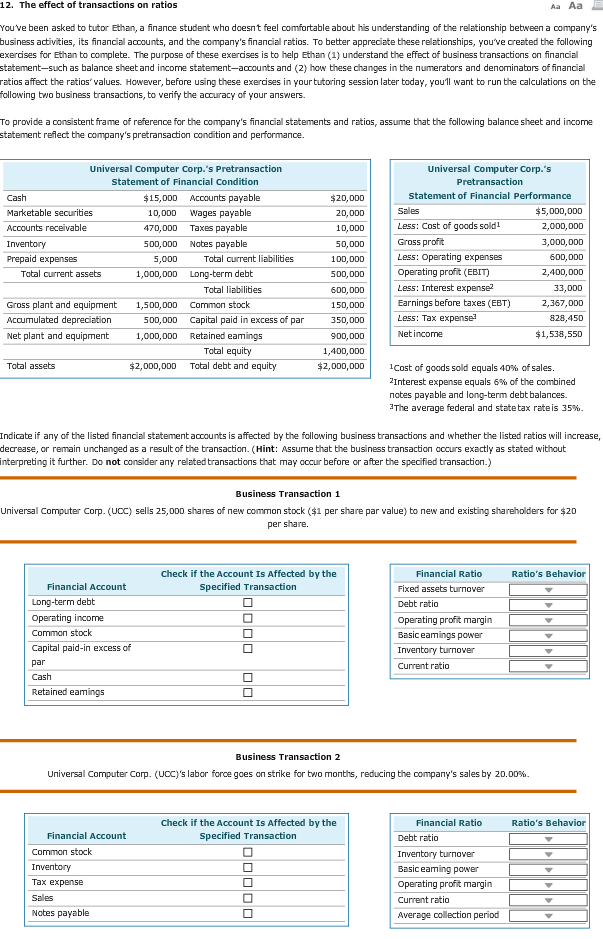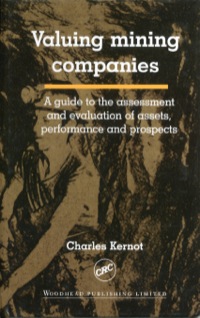
12. The effect of transactions on ratios You've been asked to tutor Ethan, a finanoe student who doesnt feel comfortable about his understanding of the relationship between a company's business activities, its financial accounts, and the company's financial ratios. To better appreciate these relationships, you've created the following exercises for Ethan to complebe. The purpose of these exercises is to help Ethan (1) understand the effect of business transactions on financial statement-such as balance sheetand income statement-accounts and (2) how these changes in the numerators and denominators of financial ratios affect the ratios' values. However, before using these exercises in your tutoring session later today, you'll want to run the calculations on the following two business transactions, to verify the accuracy of your answers. To provide a consistent frame of reference for the company's financial statements and ratios, assume that the following balanoe sheet and income statement reflect the company's pretransaction condition and performance. Universal Computer Corp.'s Pretransaction Statement of Financial Condition Universal Computer Corp.'s Pretransaction Statement of Financial Performance Cash Marketable securities Accounts receivable $15,00D Accounts payable 10,00D Wages payable 470,000 Taxes payable 500,000 Notes payable $20,000 $5,000,000 2,000,000 3,000,00D 600,0DD 2,400,000 33,D00 2,367,00D 828,450 $1,538,550 20,0DD Less: Cost of goads sold1 Less: Operating expenses Operating profit (EBIT) Less: Interest expense Earnings before taxes (EBT) Less: Tax expense Netincome Total current liabilities 100,000 500,000 600,0DD 150,000 350,0DD 900,0DD 100,0DD $2,000,000 | 5,000 Total current assets 1,000,0DD Long-term debt Total liabilities Gross plant and equipment 1,50D,0DD Common stock 50D,0D0 Capital paid in excess of par Net plant and equipment1,00D,0D Retained eamings Total Total assets $2,DDD,DDD Total debt and equity |Cost of goods sold equals 40% of sales. Interest expense equals 6% of the oombined nates payable and long-term debt balances. The average federal and state tax rate is 35%. Indicate if any of theitd financial statement accounts is affected by the following business transactions and whether the listed ratios will increase, decrease, or remain unchanged as a result of the transaction. (Hint: Assume that the business transaction occurs exactly as stated without nterpreting it further. Do not consider any related transactions that may accur before or after the specified transaction.) Business Transaction 1 Universal Computer Corp. (UOC) sells 25,000 shares of new common stock ($1 per share par value) to new and existing shareholders for $2D per share. Check if the Account Is Affected by the Specified Transaction Financial Ratio Ratio's Behavior Financial Account Long-berm debt Operating income Common stock Capital paid-in excess of Fixed assets turnover Debt ratio Operating profit margin Basic eamings power Inventory turnover Current ratio Retained eamings Business Transaction 2 Universal Computer Corp. (UCC)'s labor force goes on strike for two months, reducing the company's sales by 20.00%. Check if the Account Is Affected by the Financial Ratio Ratio's Behavior Financial Account Specified Transaction Debt ratio Inventory turnover Basic eaming power Operating profit margin Current ratio Average collection period Common stock Tax expense Nobes payable







